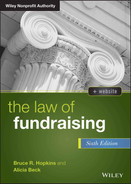Preface
This book, the sixth edition of The Law of Fundraising, is the culmination of an effort by Bruce Hopkins (hereinafter the “senior author”) that began over 40 years ago. The book is an attempt to capture the essence of the law of fundraising for charitable purposes in one volume. This task is becoming increasingly difficult. The book reflects what many in the fundraising profession painfully know: federal, state, and local regulation of fundraising just keeps expanding.
When the book originated, as Charity Under Siege: Government Regulation of Fund-Raising (published in 1980), it was less than an inch thick, yet it was thought the siege was on even then. (The senior author has heard more than one state regulator cluck at that title over the years.) Over the years, the book, thereafter published as The Law of Fundraising, expanded.
Any lawyer whose practice concentration is, like the authors', tax, corporate, and other law as it applies to charitable and other nonprofit organizations, cannot avoid entanglement in the legal morass that constitutes federal, state, and local law regulating charities' fundraising. The representation of charitable organizations by the senior author started over 50 years ago (in 1969) (the junior author emerged a mere 40 years or so later). The law of charitable fundraising has been a significant component of his practice almost from the beginning.
He vividly recalls how it all began. The day was January 20, 1973, a Saturday. A colleague at a client charitable organization telephoned him at his office in Washington, DC, excitedly reporting about a “hearing” that was to be held in a few days, before a subcommittee of the House of Representatives chaired by Rep. Lionel Van Deerlin. This impending hearing was said to concern “proposed legislation” that would create federal law of regulating fundraising by charitable organizations. The senior author was asked to inquire about this development. Knowing nothing of the proposed legislation, the upcoming hearing, Rep. Van Deerlin, or charitable fundraising in general, he promised his colleague that he would explore the matter.
Your senior author then telephoned Rep. Van Deerlin's office, hoping to find a dedicated staffer toiling there on a Saturday morning. Times were much different then: the call was answered by the congressman himself. It turned out that there was no impending hearing—rather, an informal briefing on a proposed bill was scheduled to be conducted, in Rep. Van Deerlin's office, for interested (and concerned) persons. He attended the briefing the following week, spoke up, found himself appointed to an ad hoc group formed to revise the proposal, and thus innocently wandered into the ambit of government regulation of fundraising for charity.
As the result of that client call, there unfolded innumerable meetings, telephone calls, hours of research, hearings, task forces, new nonprofit organizations, proposals, legislation, and a swirl of other developments that evolved into the contemporary body of law directed at solicitations of contributions for charitable purposes. Congressman Van Deerlin's effort to create federal statutory law in this field was unsuccessful, but certainly the pace and form of fundraising law was hardly abated.
The junior author's interest in the law of fundraising commenced in a University of Kansas School of Law classroom in the fall of 2008. The senior author had relocated his practice to Kansas City and began teaching at KU Law; the aforementioned class was his first one there. The course was a basic one on nonprofit and tax-exempt organization law, with some attention to charitable fundraising. The junior author was drawn to the intricacies of nonprofit law, earning the highest grade in the course. Four years later, your two authors began practicing law together; this book evolved from that relationship. Today, the junior author is a bank vice president, while the senior author continues in private practice. Your junior author, Alicia Beck, expresses her appreciation for the opportunity to practice with her former professor.
This edition of the book reflects an extensive revision of the previous volume. Yes, coverage has expanded again, with considerable rewriting and restructuring. The book demonstrates expansion of fundraising law on all fronts: accumulating legislation, tax regulations, IRS rulings, and case law. The U.S. Supreme Court has contributed to the shaping of this body of law, beginning with its landmark opinions in the 1980s and continuing through its finding in 2021 that state law disclosure requirements concerning donor information are unconstitutional.
Our thanks go to those who have made interesting and useful contributions to the book: James J. Bausch, James M. Greenfield, Richard F. Larkin, Paul E. Monaghan, Jr., David Ormstead, and Del Staecker. Analysis and commentary that we have written here should not, of course, be attributed to them.
Thanks go as well to those at John Wiley & Sons who have, over the years, seen editions of this book and/or their supplements to completion. In the past, gratitude and appreciation have been extended to Marla Bobowick, Martha Cooley, Jennifer MacDonald, Susan McDermott, Brian T. Neill, Claire New, and Deborah Schindlar. Our thanks are extended, this time around, to our development editor, Brian Neill, and Deborah Schindlar, managing editor, for their assistance and support in connection with this edition of the book.
Bruce R. Hopkins
Alicia M. Beck
November, 2021
